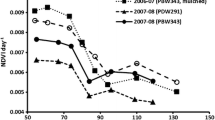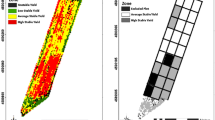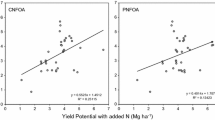Abstract
Proximal sensing, or obtaining information from close range, is a potentially useful tool for measuring the crop nitrogen status in real-time The objective of this study was to use proximal sensing of crop canopy spectral reflectance to evaluate variable-rate application of nitrogen in terms of its effect on yield and grain quality of winter wheat (Triticum aestivum L.). The sensor used was the Hydro-Precise N-Sensor System. Yield and grain quality maps were used as a basis for full-scale field trials with winter wheat growing under four nitrogen application treatments: a large (274 kg ha−1), recommended (167 kg ha−1) and two sensor-assisted (167 kg ha−1) rates. The recommended rate of 167 kg N ha−1 was given in a three-split application that meets the present Danish regulations to reduce nitrogen leaching. These require arable farmers to decrease nitrogen fertilizer application to 90% of the economically optimal level. Each farm’s baseline is calculated to take into account land quality, land allocated to each crop, and crop rotation. In the two sensor-assisted applications the Hydro-Precise N-Sensor System directs the last two of the three-split N application. Grain samples were collected directly from the grain flow of a combine harvester and analysed for protein, water and starch content. Grain data were related to and compared with combine yield meter registrations. Within the field, the variances of protein yield (698–1208 kg ha−1) and grain protein (9.5–13.4%) were large. The nitrogen application treatments affected the average protein content (10.5–12.3%) and grain yield (9.87–10.42 t ha−1) strongly. The grain starch content was largest in the uniform and sensor applied systems and smallest in the high nitrogen application treatment. Applying nitrogen according to the Hydro-Precise N-Sensor System did not increase grain yield or the protein and starch contents. Minor differences only were observed in both protein content and yield between uniform-rate N application and sensor-based variable-rate N application.




Similar content being viewed by others
References
Barnes E, Clarke T, Colaizzi P, Haberland J, Kostrzewski M, Riley E, Moran M, Waller P, Choi C, Thompson T, Richards S, Lascano R, Li H (2000) Coincident detection of crop water stress, nitrogen status, and canopy density using ground–based multispectral data. In: Robert PC, Rust RH, Larson WE (eds) Proceedings of the 5th International Conference on Precision Agriculture and Other Resource Management, ASA-CSSA-SSSA, Madison, WI, USA, CD-ROM
Berntsen J, Thomsen A, Schelde K, Hansen OM, Knudsen L, Broge N, Hougaard H, Hørfarter R (2006) Algorithms for sensor-based redistribution of nitrogen fertilizer in winter wheat. Precision Agric 7:65–83
Box GEP, Jenkins GM, Reinsel GC (1994) Time series analysis: forecasting and control. 3rd edn. Prentice-Hall, Inc., New Jersey, USA
Delin S (2004) Within-field Variations in grain protein content-relationships to yield and soil nitrogen and consistency in maps between years. Precision Agric 5:565–577
Engel EE, Long DS, Carlson GR, Meier C (1999) Method for precision nitrogen management in spring wheat: I fundamental relationships. Precision Agric 1:327–338
Fiez TE, Miller BC, Pan WL (1994) Winter wheat yield and grain protein across varied landscape positions. Agron J 86:1026–1032
Gitelson AA, Merzlyak MN (1997) Remote estimation of chlorophyll content in higher plant leaves. Int J Remote Sens 18:291–298
Hansen PM, Jørgensen JR, Thomsen A (2002) Predicting grain yield and protein content in winter wheat and spring barely using repeated canopy reflectance measurements and partial least squares regression. J Agric Sci 139:307–318
Heege JJ, Reusch S (1996) Sensor for on the go control of site specific nitrogen top dressing. ASAE Paper 961018, ASAE, St. Joseph, MI, USA
Hydro Agri Precise (2000) Precise: a sixth sense for agriculture. (Hydro Agri Precise, Upton, UK
Joernsgaard B, Halmoe S (2003) Intra-field yield variation over crops and years. Eur J Agron 19:23–33
Jørgensen RN, Jørgensen JR (2001) Design of a grain sampling device for combines equipped with a differential global position system (DGPS) and yield meter. In: Grenier G, Blackmore S (eds) Proceedings of the 3rd European Conference on Precision Agriculture, AGRO Montpellier, France, p 809–814
Lancashire PD, Bleiholder H, Vandenboom T, Langeluddeke P, Stauss R, Weber E, Witzenberger A (1991) A uniform decimal code for growth-stages of crops and weeds. Ann Appl Biol 119:561–601
Link A, Panitzki M, Reusch S (2002) Hydro N-Sensor: Tractor-mounted remote sensing for variable nitrogen fertilization. In: Roberts PC (ed) Proceedings of the 6th International Conference on Precision Agriculture and other Precision Resources Management, ASA-CSSA-SSSA, Madison, WI, USA, p 932–937
Long DS, Engel RE, Carlson GR (2000) Method for precision nitrogen management in spring wheat: II. implementation. Precision Agric 2:25–38
Lukina EV, Freeman KW, Wynn KJ, Thomason WE, Mullen RW, Stone ML, Solie JB, Klatt AR, Johnson GV, Elliott RL, Raun WR (2001) Nitrogen fertilization optimization algorithm based on in-season estimates of yield and plant nitrogen uptake. J Plant Nutr 24:885–898
McBratney AB, Webster R (1986) Choosing functions for semi-variograms of soil properties and fitting them to sampling estimates. J Soil Sci 37:617–639
McDonald GK (1992) Effects of nitrogenous fertilizer on the growth, grain-yield and grain protein-concentration of wheat. Aust J Agric Res 43:949–967
Penuelas J, Filella I (1998) Visible and near-infrared reflectance techniques for diagnosing plant physiological status. Trends Plant Sci 3:151–156
Raun WR, Solie JB, Johnson GV, Stone ML, Mullen RW, Freeman KW, Thomason WE, Lukina EV (2002) Improving nitrogen use efficiency in cereal grain production with optical sensing and variable rate application. Agron J 94:815–820
Reusch S (1997) Entwicklung eines reflexionsoptischen Sensors zur Erfassung der Stickstoffversorgung landwirtschaftlicher Kulturpflanzen (Development of an optical-reflectance sensor for determining the nitrogen supply for agriculturally cultivated plants). Unpublished Ph.D. Thesis, Christian-Albrechts-University of Kiel, Germany
Rodriguez D, Sadras VO, Christensen LK, Belford R (2005) Spatial assessment of the physiological status of wheat crops as affected by water and nitrogen supply using infrared thermal imagery. Aust J Agric Res 56:983–993
Skjødt P (2003) Sensor based nitrogen fertilization increasing grain protein yield in winter wheat. In: Jørgensen RN, Hansen PM (eds) Risø Report, Risø-R−1389(EN), Risø National Laboratory, Roskilde, Denmark
Stone ML, Solie JB, Raun WR, Whitney RW, Taylor SL, Ringer JD (1996) Use of spectral radiance for correcting in-season fertilizer nitrogen deficiencies in winter wheat. Trans ASAE 39:1623–1631
Wollring J, Reusch S, Karlsson C (1998) Variable nitrogen application base on crop sensing. Proceedings No. 423 The International Fertiliser Society, York, UK, p 3–27
Wollring J, Reusch S (1999) Stickstoff variabel düngen–Sensor mißt Versorgung der Pflanzen (Variable nitrogen application - Sensor measured supply of the plants). In: DLZ Agrarmagazin (eds) Sonderheft 10. BLV-Verlag, München, Germany, p 30–34
Vrindts E, Reyniers M, Darius P, De baerdemaeker J, Gilot M, Sadaoui Y, Frankinet M, Hanquet B, Destain MF (2003) Analysis of soil and crop properties for precision agriculture for winter wheat. Biosyst Eng 85:141–152
Acknowledgements
The project was partly funded by the Danish Ministry of Food, Agriculture and Fisheries. The authors wish to acknowledge Hydro Agri Denmark for supporting the N-Sensor system. Thanks are also expressed to the technical staff at the Danish Institute of Agricultural Sciences, Department of Genetics and Biotechnology, and the Risø National Laboratory, Department of Plant Biology and Biogeochemistry.
Author information
Authors and Affiliations
Corresponding author
Rights and permissions
About this article
Cite this article
Jørgensen, J.R., Jørgensen, R.N. Uniformity of wheat yield and quality using sensor assisted application of nitrogen . Precision Agric 8, 63–73 (2007). https://doi.org/10.1007/s11119-006-9029-2
Received:
Accepted:
Published:
Issue Date:
DOI: https://doi.org/10.1007/s11119-006-9029-2




